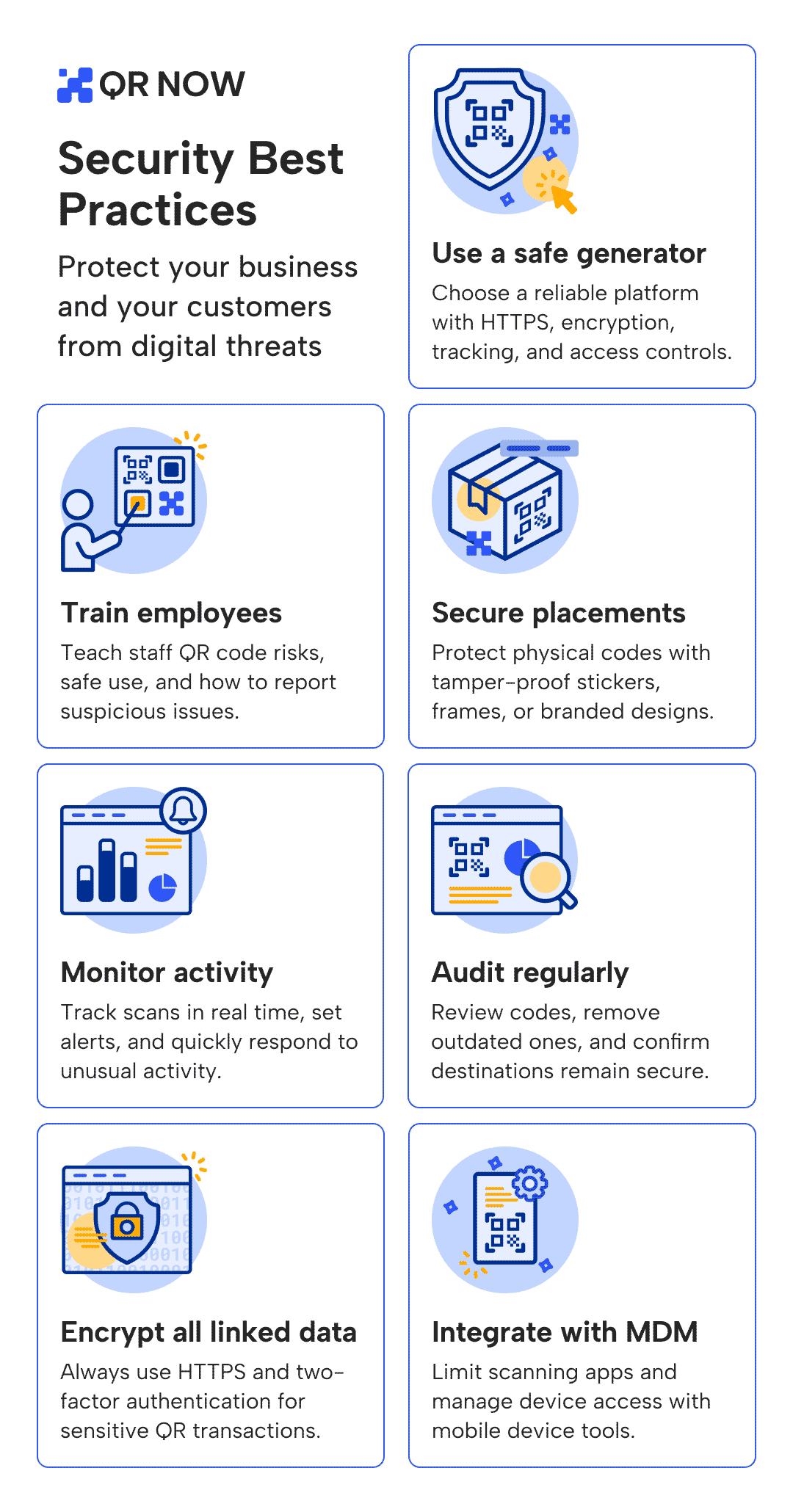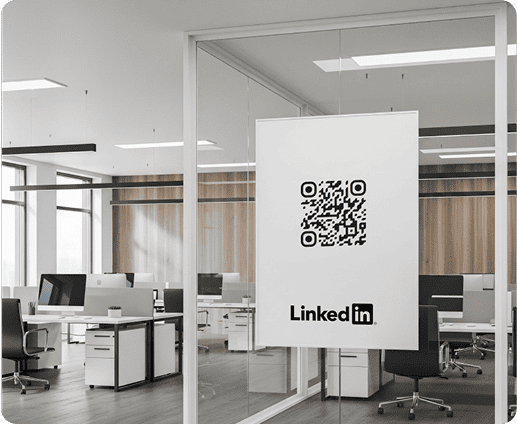Common QR Code Security Threats
A QR code looks pretty harmless, but it can be exploited by criminals. Businesses can face a variety of risks, and need to stay vigilant. Let's examine a few of the potential cybersecurity threats, and later we’ll provide tips on how to keep your QR codes safe.
Phishing via QR codes (Quishing)
Phishing is a type of online scam in which criminals impersonate someone you trust to trick you into disclosing personal information, such as passwords or bank details.
Lately, scammers have started using a new trick called quishing. Instead of sending regular links, they send QR codes. These QR codes can be shared in various ways, such as through emails, text messages, social media, or even printed and placed on posters, flyers, or restaurant tables.
When you scan the QR code, it may direct you to a fake website that appears genuine but is actually designed to steal your information. Because you cannot read a QR code just by looking at it, and since we usually scan them quickly with our phones, it’s easy to miss the danger.
Physical QR code replacement
Printed QR codes in public places can be easily messed with or swapped out. Scammers sometimes overlay fake QR codes on top of real ones to trick people into visiting malicious websites. For example, someone trying to pay for parking might scan a fake code and inadvertently enter their card details on a problematic page.
These types of QR code scams now account for over 20% of all online scams, indicating just how common they have become.
Malware and spyware distribution
Some QR codes are made to automatically download harmful files onto your phone the moment you scan them. The big issue here is that you won’t see any warnings or prompts—it just happens in the background.
Scammers hide these QR codes in counterfit posters, discount ads, or event flyers that look real. Then the unknowing victims scan them thinking they’ll get a good deal or useful information, but instead, they end up infecting their phones.
The files that those who are duped accidentally open can include spyware, keyloggers, or viruses that let hackers secretly control their phone. And once that happens, they can watch what their victims are doing on their smartphones, or steal personal information.
Wi-Fi spoofing via QR codes
QR codes make it easy to join a Wi-Fi network by just scanning a code. However, hackers can exploit this by creating fake QR codes that connect your phone or laptop to a compromised Wi-Fi network, also known as an "evil twin" hotspot.
From there, they can spy on your online activities or steal personal information.
QR Code Security Regulations
In 2023, cybersecurity experts warned that QR codes are becoming a bigger risk in both public and private places. With a significant rise in phishing attacks, businesses are being advised to take safety steps to protect their employees and comply with the law.
Many industries have implemented measures to stop people from misusing QR codes. In banking, companies must adhere to strict rules that protect customer data. These rules include GDPR, PCI DSS, and PSD2.
These regulations state that companies must use secure methods to send data, such as using protected QR codes and ensuring device security. In the same way, hospitals and clinics that use QR codes for appointments or vaccine records must follow HIPAA rules to prevent the inadvertant sharing of patient information.
To follow the rules and keep online information safe, businesses should control who can access their systems, protect all data connected to QR codes, and regularly check the devices or systems that use these codes. It also helps to work with QR code providers who include safety and rule-following features in their services.
When you incorporate QR safety steps into how you use these codes, you not only protect your customers but also avoid potential future legal or financial issues.
How To Implement Robust Security Measures for Your QR Codes
Now that you are aware of the dangers, let’s discuss how to protect your QR codes. These tips will help you secure your QR codes and protect your business and customers from emerging threats.

Use a trusted QR code generator
Choose a trusted platform that offers safety features such as secure links (HTTPS), encryption, scan tracking, and access control. This way, you can make your own branded QR codes, update them when needed, see how they’re being used, and make sure every scan is protected.
Monitor QR code activity in real time
Use scan tracking and location alerts. If you see a sudden jump in scans from places you do not expect, it could mean something’s wrong. A central dashboard can help you identify these issues, set up alerts, and take swift action if anything unusual occurs.
Train employees on QR code security
Be sure your team knows the risks and how to use QR codes safely. They should check printed codes often, avoid using dubious QR code tools, and report anything that looks suspicious. Include these steps in your company’s regular cybersecurity training.
Secure physical QR code placements
One of the most common ways attackers trick people is by messing with physical QR codes. To prevent this, use tamper-proof stickers, locked frames, or digital screens that display the code. You can also add your logo or branding to the QR code so people know it’s the real one and not a fake.
Encrypt all linked data
Every website link or file connected to a QR code should be protected with HTTPS (TLS encryption) to ensure security. If the QR code is used for sensitive transactions like payments or logging in, be sure to use two-step verification so only the intended person can access it.
Integrate with mobile device management (MDM)
If your company uses QR codes on employee devices, MDM tools can help keep everything secure. These tools enable you to control which apps are allowed to scan QR codes and ensure that only approved devices can access private or company-specific links.
Perform routine QR code audits
Set up a regular process to manage all your QR codes. Check which ones are still in use, make sure that they lead to the right places, remove any that are no longer needed, and confirm they’re still in the right spots. Doing this helps prevent scammers from misusing old or tampered codes.
Get started with your first QR code today
Enjoy a 7-day free trial and access every customization feature to make your QR codes stand out from the rest.
Create my QR Code
Choose Secure QR Code Solutions
According to Statista, more people are using QR codes, and in 2025, over 100 million people in the U.S. are expected to be using mobile QR code scanners. This illustrates the growing importance of QR codes in everyday business. Because of this, it is crucial to use safe and reliable QR code tools.
Go for platforms like QRNow.com that make sure your links are secure, let you change codes even after you’ve shared them, and give you control over who can use them. When you choose the right platform you'll see that there are also tools to track how your codes are being used and let you connect them with other apps.
It's safer to go with dependable providers that have certifications like ISO or SOC 2 which demonstrate that they follow strict rules to ensure your data is well-protected. Using reputable and secure QR code tools helps protect your business, your brand’s reputation, and the trust your customers have in you.
Future Trends in QR Code Security
A recent study by Juniper Research shows that people around the world are expected to spend more than $3 trillion using QR code payments by 2025, up from $2.4 trillion in 2022. This 25% increase is mainly because more countries are working to make financial services easier to access and are also offering new ways to pay besides traditional methods.
Obviously, such accelerated growth calls for smarter, better-protected QR code systems. Luckily, some great minds are working on new ideas, and we've outlined a few of them for you here.
- Smarter threat detection with AI. Some QR tools are starting to use artificial intelligence to spot anything strange, like too many scans in a short time or from odd locations. This helps stop scams before they happen.
- Extra checks for every scan. Companies are moving toward a “never trust, always verify” approach. Each time a QR code is scanned, it will go through checks, such as confirming who’s scanning and from what device.
- Double security for sensitive scans. Just scanning a QR code won’t be enough for confidential transactions. Fingerprint or facial recognition can also be implemented as a requirement in the verification process.
- QR codes backed by blockchain. Some QR codes will use blockchain to keep a secure record of every scan, making it almost impossible to fake and great for tracking movements.
- Instant warnings and helpful tips. One development we are waiting for that will really be groundbreaking in security, is for QR scanners that will immediately alert you if the link you’re about to open looks suspicious, and give you tips to stay safe.
- Better tools for businesses. QR scan data will be connected to company security systems so they can spot problems quickly and respond faster if something goes wrong.
Conclusion
As more businesses start using QR codes, keeping them safe needs to be a top priority. It’s fundamental to understand the risks associated with them and put strong safety measures in place to protect your customers and their data. Adhering to regulations, using secure QR code tools, and keeping an eye out for potential vulnerabilities are not just a sensible option; they are a must.
Taking QR code security seriously now will help your business and its reputation stay strong in the future. You must set out to work with partners who understand your security needs and can keep up as as cybercrime evolves.
A solid security plan does not just protect your business, it also helps build trust and keeps your customers coming back.
FAQs
Are there security concerns with QR codes?
Toggle faqs
Yes, cybercriminals can use QR codes to trick people into opening dangerous websites, stealing their personal information, or spreading viruses. Many people scan QR codes without verifying their origin, which makes it easy for scammers to take advantage.
In fact, a 2023 study examined 38 companies in nine different industries across 125 countries and found that 22% of phishing attacks in early October used QR codes to spread harmful software. To stay safe, only scan QR codes if you know and trust the source.
How do I make my QR code secure?
Toggle faqs
To keep your QR code secure, use a reliable QR code generator that offers encryption, lets you update the link later, and tracks who scans it. Always make sure the link goes to a secure HTTPS website. Closely monitor how often people scan your code, and think about how you can add logos or custom designs to make it harder to tamper with. There are also measures you can implement to make the code expire after a certain time or restrict who can use it.
Can QR codes be a security risk?
Toggle faqs
QR codes can be a security risk if not properly checked. Hackers might swap out real codes with fake ones in public places or use them to trick people into disclosing personal information. To protect both businesses and users, organizations should use extra security measures, like verifying scans and requiring users to log in before accessing sensitive data.





